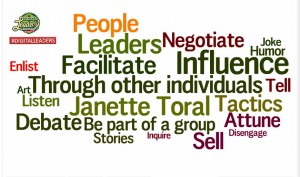13 Tactics to Influence People
 B. Kim Barnes, author of the book “Exercising Influence,” said that there are thirteen tactics to influence people: tell, sell, negotiate, enlist, inquire, listen, attune, and facilitate. When our authority to do such is not established, we can also influence indirectly through other individuals, being part of a group, debate, disengaging, and humor.
B. Kim Barnes, author of the book “Exercising Influence,” said that there are thirteen tactics to influence people: tell, sell, negotiate, enlist, inquire, listen, attune, and facilitate. When our authority to do such is not established, we can also influence indirectly through other individuals, being part of a group, debate, disengaging, and humor.
However, influence is a two-way street and one must be both expressive and receptive at the same time. A one-sided influence is not sustainable. Those who fail to give back will lose their influence in the long run.
The first four are under expressive influence. This is when we voice out our ideas and energy to others. This includes:
1. Tell
– “Let’s review every Friday until we complete the sponsors line-up.” (suggest)
– “I need your outline for the book by Monday.” (express needs)
2. Sell
– “That way, we can meet the sponsors cut-off date.” (offer reasons)
– “With both of us working on it, we should be able to get the book concept reviewed by the publisher for approval.” (refer to shared values or goals)
3. Negotiate
– “If you extend the deadline for another month, I could get 5 case studies that we can use as a bonus material.” (offer incentives)
– “If you don’t finish that by Sunday, the book won’t be released on April 26.” (describe consequences)
4. Enlist
– “I can see this election blogging project as a demonstration of citizen journalism.” (envision)
– “You are the kind of person who can make government officials take bloggers seriously. You have the authority to make them listen to you.” (encourage)
The next four are under receptive influence. This is when we invite ideas and stimulate action. This includes:
5. Inquire
– “What kind of online training programs will interest you?” (asking open-ended questions)
– “You said that charter change is an important issue in the next election. Tell me more about that.” (draw out)
6. Listen
– “So from your point of view, the trainer has no experience in running a paid membership site that makes you uncomfortable with the whole thing.” (check understanding)
– “I’m getting the impression that you detest the idea.” (test implications)
7. Attune
– “If I were you, I will be concerned on how will this affect your business.” (identify with other)
– “I did not take this seriously the last time we discussed this.” (disclose)
8. Facilitate
– “It seems you are just continuing that project out of concern as no one else will pick up the ball.” (clarify issues)
– “What would it take for you to sponsor this bill?” (pose challenging questions)
When our authority or personality to influence is not yet established, there are still means to do it indirectlysuch as:
9. Through other individuals
– Get a person who is in a better position to influence. They may not be as knowledgeable but they have the authority to bring the issue forward.
– “The industry needs a trusted champion who can lead this effort. We’ll do the necessary back staff work to get you covered until the end.”
10. Be part of a group
– Make a personal cause to a group cause especially if it has a widespread impact. This could be by joining an existing group or by forming one.
11. Debate
– Intended to influence the audience of an issue more rather than the person who pushes a specific position. For example, an unchallenged group is pushing for charter change. With no direct influence, you can put out a position to spark a debate. The audience will be the one to judge the winners of the debate.
12. Disengage
– Rather than go head-on about a particular issue, use time to further understand the concerns at hand and not immediately come to a position. Influence can still be exerted through other individuals and to the party directly.
13. Humor (joke, art, stories)
– Directed at a force or third party, but not sarcastic. There are cartoonists, artist, and authors who have done well in this field.
Reflection:
What tactics are you using to influence ? Have you succeeded so far?